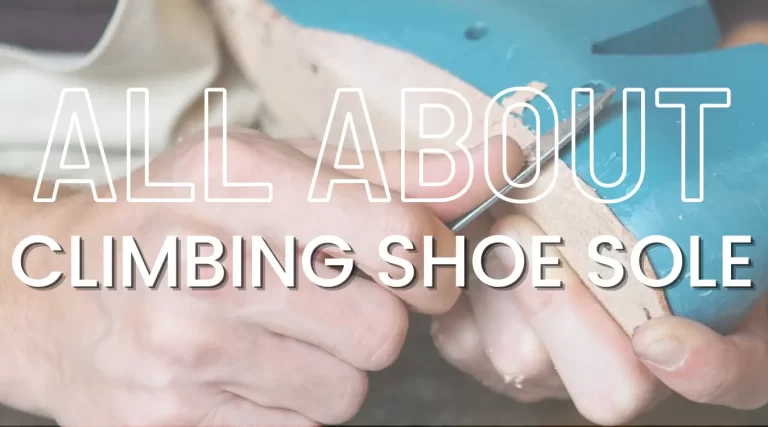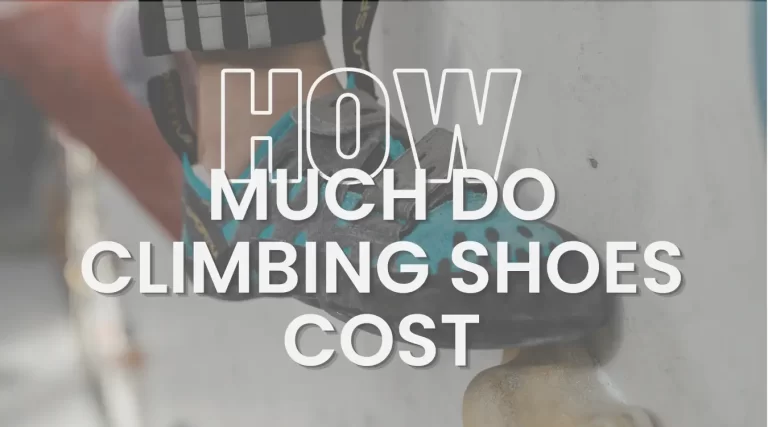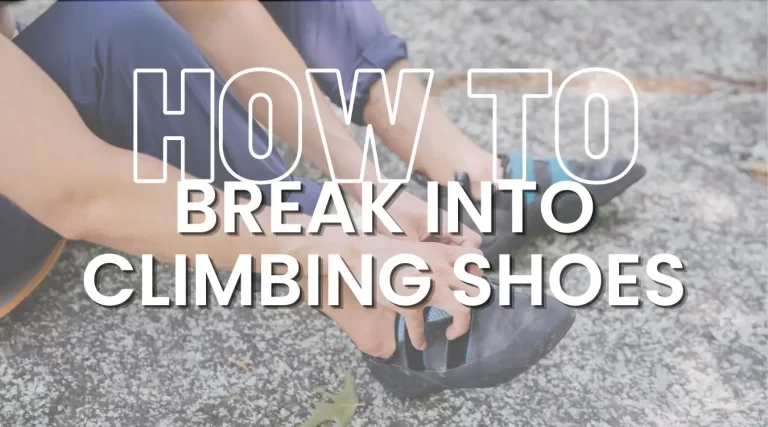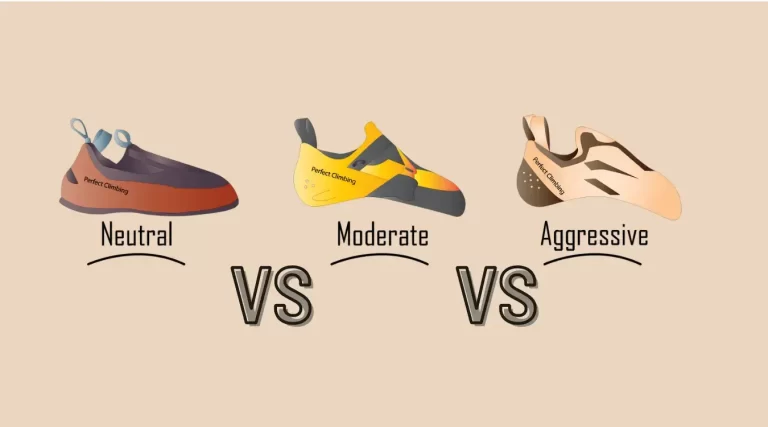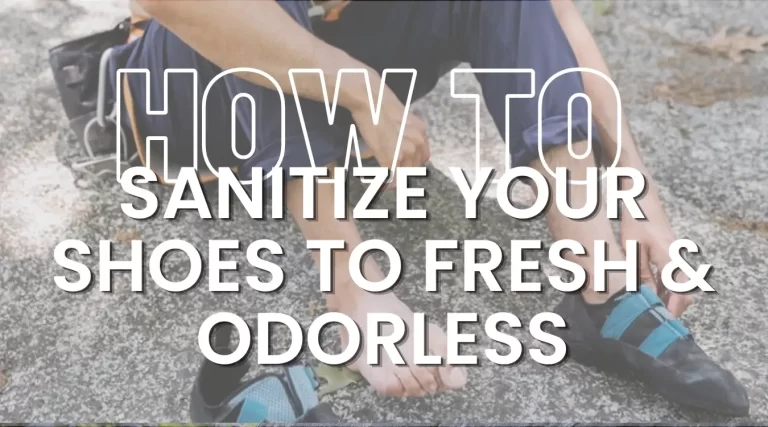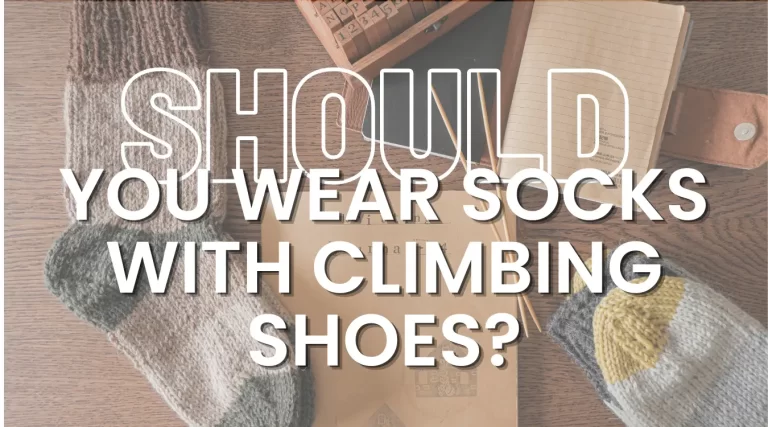Finding a good fit for your climbing shoes can seem daunting, especially if you are a beginner. It is important to keep in mind that rock climbing shoes are different from, say, formal shoes or your usual athletic shoes.
Well-fitting climbing shoes are essential for you to climb well and comfortably. After all, it should be an enjoyable experience, not a painful one.
The general rule of thumb is this: your climbing shoes should not feel pain when you wear them. They should be tighter than regular shoes but not so tight to cause discomfort.
There is a general misconception that climbing shoes are meant to be worn tightly. As a consequence, people tend to buy smaller-sized climbing shoes. This leads to a painful experience. Wearing too tight a shoe can eventually cause ingrown toenails and calluses.
The fit of your shoes can vary, however. It depends on the construction of the shoe, the terrain, and the kind of climbing you’re looking to do.
Here we will discuss a few essential factors that will help you find the perfect fit for your climbing shoe.
The Way Climbing Shoes Are Supposed To Fit.
Remember that your climbing shoes should not cause pain or discomfort. They should be snug. Neither too tight nor too loose. What do we mean by a snug fit?
It means that there shouldn’t be extra space between your feet and the shoes. The shoe should be held against your skin but within a comfortable limit. Your toes should be in the toe box, and the sides of your feet should just touch the sides of the shoe.
Your climbing shoe should feel like you have an extra layer of skin over your skin. It should be touching closely to your skin.
What happens if there is extra space? You won’t be able to perform a precise movement or hold your ground at a rock with little room. To climb well, there should not be dead space inside your climbing shoe.
On the flip side, if your shoes are too tight, then you’ll feel discomfort and won’t be able to climb well either.
In simple terms, the fit of your shoe should be snug, neither too small nor too big. They should not be painful or uncomfortable. The fitting should be just proper.
You’ll need to try on quite a few pairs of shoes to achieve optimal fitting. You should take your time because when it comes to climbing, your shoes are your most important weapon.
It is also worth mentioning that different brands make different kinds of shoes. Even for the same number, the fitting can be other. Therefore, according to the criteria discussed above, you should wear a shoe that seems comfortable for you.
Curl or no curl?
It is also unclear among a lot of beginners whether your toes should be curled inside your climbing shoe or not.
You need to remember: that your toes should never be flat inside the climbing shoe.
There is a reason for this. You need your toes to be curled to be able to hold your weight on small edges. If your feet are lying entirely, you won’t be able to climb properly.
If you’ve tried a shoe where you feel that your toes lie entirely flat, you shouldn’t buy it.
Even a slight curl is essential. It varies from beginner to high-performance shoes. Beginner shoes tend to have less downturn or camber. The higher-performance shoes, on the other hand, have a significant downturn.
Whatever the shoe type, you now know that your toes must be curled inside the climbing shoe, even if it’s a slight curl.
If your shoe is a perfect fit, you’ll notice that your toes will feel slightly curled and won’t be lying flat. If the shoe is loose, the toes will surely be unable to bend.
Why shouldn’t climbing shoes be spacious?
A thing you need to remember regarding climbing shoes is: that while wearing them, you should feel like you’re climbing barefoot. That is why there should not be extra space, even though it may seem comfortable.
However, it should be kept in mind that your feet can expand a bit if you’re climbing in hot weather. This can alter the initial fitting. So to avoid discomfort, you should size up a little.
The build of a climbing shoe is an essential factor in finding a good fit
There are two kinds of climbing shoes. Soft and stiff.
The stiff shoes have to be less tight because their slightly hard platform can support you independently. Wearing these shoes would generally be comfortable.
Soft shoes must be tight; they depend on tight fitting to create support.
While buying shoes, you need to keep this factor in mind.
The downturn of a shoe, as discussed above, is critical too. If your shoe is aggressively curved, it shouldn’t be loose. The fit has to be just right for you to achieve maximum performance.
Climbing shoes generally have a leather upper or a synthetic one. Often it can be a combination of both.
Leather shoes can stretch more upon wearing compared to synthetic upper ones.
So, you need to be careful while buying these. You would want to buy a tighter fit so that when eventually they stretch, you’ll have a good, snug fit.
Importance of closure
There are three closure systems in climbing shoes: laces, velcro straps, and slip-on.
Laces can give you more versatility, and you can tighten or loosen your shoe fitting as required. Especially in hot weather, when your feet tend to expand, you can loosen the laces.
Straps are less versatile but are very quick and efficient. They won’t be able to do much regarding fitting, though.
For slip-on, you’ll have to buy a size that fits well because you can’t alter the fit here like laces. The advantage of having slip-on climbing shoes is that they are perfect for crack climbing and provide you with good sensitivity.
Climbing Style
Your preferred climbing style and type will determine the type of shoes you would want to wear. Wearing a specific shoe pair for a defined job will allow you to get the best out of them.
Here we have provided the features of the best shoes for each type of climbing.
Bouldering and Sports Climbing
As we all know, bouldering is all about quick and fast climbing. You are not in need of ropes and harnesses as all you need is a good pair of climbing shoes, and these shoes should be at their absolute best during this adrenaline climbing.
Shoes needed for bouldering and sports climbing better have a good grip provided by the downturned shoes, which are specialised for transferring your body weight onto the toes for better grip. Sensible and aggressive shoes both have downturned shapes, and one of them should be your choice, depending on how steep the surface is.
This type of climbing is for a short period, so you should also choose the Velcro strap type of closure system as they are easy for taking off and on. Slip-on shoes will also do fine, but straps are recommended.
Shoe sizing is equally important as any other thing in choosing shoes. As we mentioned above, it is a quick type of climbing, so people prefer slightly tight shoes with a snug fit as these are focused more on performance instead of comfort. But these should not be tight as foot injuries due to extra tight shoes are prevalent.
When we talk about the shoe’s outsole, you should go for the shoes with a thin sole and sticky rubber as these provide better grip.
So the bottom line is that for bouldering or sports climbing, you choose moderate or aggressive shoes with a strap closure system and a thin sole with sticky rubber.
Multi-pitch climbing and all-day use
Multi-pitch climbing is different from bouldering climbing as it tests your endurance and skill for extended periods, like a whole day. It involves more than one route and a destination known as the belay station. You have ropes and harnesses, unlike bouldering climbing, so instead of grip, comfort and support are the priorities.
For this type of climbing, you choose comfort without compromising the performance. Flat shoes are your go-to option, but slightly downturned shoes are not a wrong choice either. So we would advise you to get a beginner or moderate shoes centred around comfort for climbing.
As this is an all-day activity, you keep your shoes on almost all the time; it is good to have a lace type of closure system that gives you the versatility of keeping the shoes tight or loose. For the outsole, you should go for a thick sole and firm rubber, as these are specialised for providing better support to your feet.
Regarding shoe sizing, these should be tight but not so tight to cause you pain or discomfort as you will not be able to climb all day with your feet hurting.
In conclusion, you should look for beginner or moderate shoes with a slight downturn focused on comfort. A laces closure system with a thick outsole of firm rubber should do the work.
Traditional Climbing
For traditional climbing, the shoes also need to have some extra features which are not seen in the shoes used for other types of climbing. The shoes need a flat and supportive underside so that a good amount of support and force can be generated to hold on to steep rocks or pull oneself up.
The shoes also need extra space for the foot and the toes to move around. This will allow appropriate torque when moving around tight spaces and tiny cracks. The area needs to be enough so that the toes are slightly curled but aren’t overstuffed too much.
Crack Climbing
For climbing through cracks, you need an excellent jamming pair of shoes. This is because the climber needs a good hold using the shoes during jamming so that reasonable force can be transmitted.
This is where an aggressive shoe can not do the proper job because it can not create an effective jamming force. Exceptionally downturned shoes will also not be effective in this case. Thus for proper crack climbing, the shoes should not be overly aggressive.
Climbing Intensity
Another essential thing to consider when choosing the best-fitting shoes is to decide how much intensity you will put into the climbing process.
For indoor climbing sessions like gym climbing, we recommend going for a more roomy pair that can give a relaxed fit. This is because, in the gym, you don’t need an aggressive pair that gives more downturn but a pair that offers more comfort than performance.
For bouldering sessions, you would want to put on the shoes more developed in the performance department because you need every last bit of the juice you can get out of the shoes.
Lastly, you will have to put on the tightest shoes for tricky climbing and outdoor hiking jobs. This is because comfort isnt always the priority during these jobs, and maximum performance is needed.
FAQ’s
What should i need for climbing through shoe cracks?
For climbing through cracks, you need an excellent jamming pair of shoes. This is because the climber needs a good hold using the shoes during jamming so that reasonable force can be transmitted.
What is difference between Multi-pitch climbing and bouldering climbing
Multi-pitch climbing is different from bouldering climbing as it tests your endurance and skill for extended periods, like a whole day. It involves more than one route and a destination known as the belay station. You have ropes and harnesses, unlike bouldering climbing, so instead of grip, comfort and support are the priorities.
Conclusion
Now you know the answer to the hundred-dollar question, how should climbing shoes fit. In the end, it all comes down to your personal preference. If you want the maximum performance out of your climbing shoes, go for the ones with a tighter fit and less roomy outfit. On the other hand, if you want more comfort from them, use the ones with more soft materials and less tight inside. We hope all your climbing sessions will be full of fun and energy. Happy climbing.

